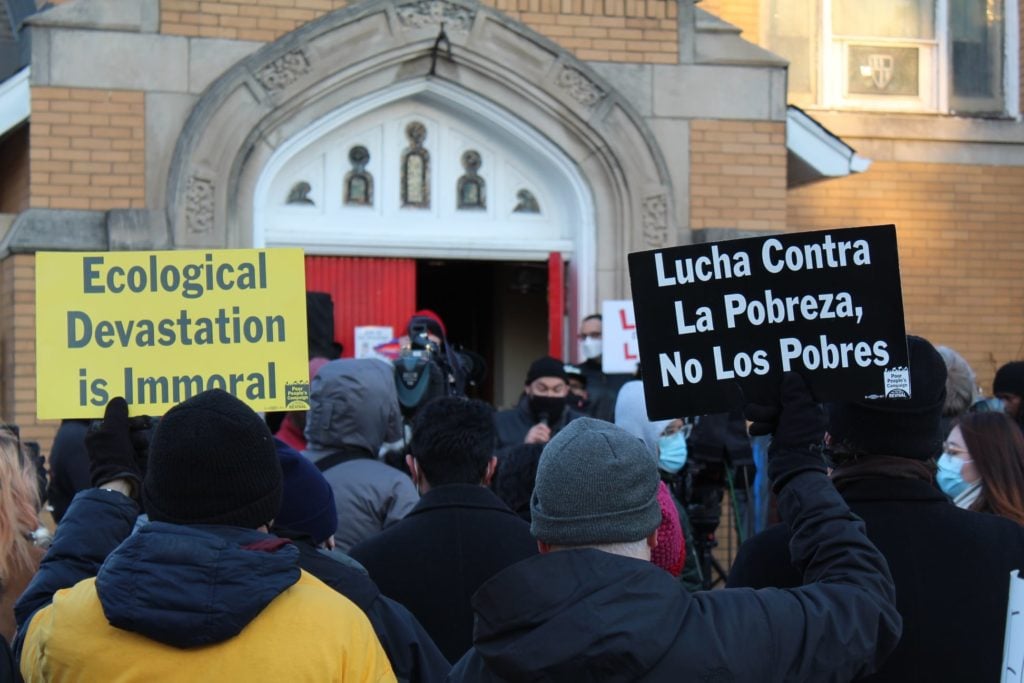Photo: Protesters hammer nails into a casket representing the lives lost to decades of environmental racism in Chicago. Liberation photo by Drake Stewart
On March 4, hundreds of protesters gathered outside Chicago Mayor Lori Lightfoot’s home in the Logan Square neighborhood to protest notorious polluter General Iron. The rally was organized after Lightfoot ignored the demands of several hunger strikers opposed to the opening of the toxic metal recycling site in an already extremely polluted Southeast Side neighborhood.
General Iron currently operates in an affluent Northside neighborhood, but has requested a permit from the city of Chicago to move their operations to a predominantly Latino neighborhood on the Southeast Side of Chicago. The new site, where General Iron has already begun construction, is blocks away from several schools. This potential move has resulted in a city-wide campaign demanding that Mayor Lori Lightfoot deny General Iron an operating permit.
Activists assert that industry and city leaders are taking advantage of the Southeast Side’s economic situation, using the promise of jobs to gloss over the environmental and health effects of living next to a major polluter. In early February, with construction at the new site continuing and no word from city leaders, activists from the Southeast Side decided to go on a hunger strike demanding that General Iron be denied a permit.
The gathering on March 4 marked the end of the hunger strike and served as a vigil mourning the health of those who had been without solid food for a month. Oscar Sanchez, one of the first hunger strikers, told the crowd: “We are environmentally burdened. … Enough is enough!”
Yesina Chavez, an organizer with United Neighbors of the 10th Ward, urged people to come together and keep fighting: “In order to continue, we’re going to give our body nutrients. We’re going to go back to eating, and we’re going to continue the fight. But we’re not going to do it alone.”
Many of the speakers were students from George Washington High School, located half a mile from the proposed facility. “There’s no reason why I should starve for a week to get Lori’s attention,” said Gregory Miller, a 15-year-old student organizer.
After the initial speeches, the protesters moved into the streets chanting “El pueblo unido jamás será vencido!” [“The people united will never be defeated!”] Mayor Lightfoot’s home was sectioned off entirely by dozens of officers from the Chicago Police Department. The block itself was also barricaded, forcing protesters to move into the main streets, blocking traffic and taking over intersections.
Protesters clad in funeral attire carried a casket while marching through the Logan Square neighborhood of Chicago. The casket represented the lives lost to decades of environmental racism. According to the City of Chicago’s Air Quality and Health Report, air pollution contributes to increased risk of chronic disease, which is the leading driver of Chicago’s nine-year life expectancy gap between Black and white residents, and decreases in life expectancy in the Latino population.
Protesters marched back to the initial location of Grace United Methodist Church outside Lightfoot’s home chanting “No justice, no peace!” and “Whose streets? Our streets! Whose city? Our city!”

One of the month-long hunger strikers, known as KiD, told Liberation News: “The demand is simple … for Lori Lightfoot to deny the permit. She knows she has the power to do it. General Iron has caused too much problems in residential communities as far as explosions, fires, and they have federal EPA citations. If the North [Side] doesn’t want it, we don’t want it neither.”
The protests have gained national attention, opening up a federal investigation into former Mayor Rahm Emanuel’s dealings with General Iron. Lightfoot has refused to meet with protesters, though she has asked for some direction from the EPA. While activists have now concluded their hunger strike, they remain committed to continue taking action to stop the relocation of the plant.
KiD continued: “The people deserve clean air. Biden spoke about environmental justice and we haven’t seen any action yet. We, the people, will be heard. We, the people, will win.”





